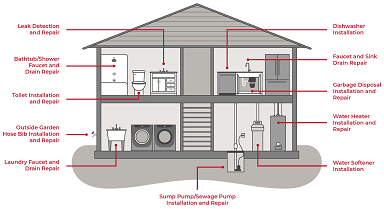 Think of the plumbing pipes running through your home as blood vessels and arteries. Just as the body requires the proper flow of blood throughout, to function properly, so your home needs proper inflow and outflow of water sources to function properly. There are few things that the average person can do in a home where plumbing is not involved. As the body can present hidden damages, so can your home. Pipes may be partially clogged in places that could restrict the flow of water into or out of the home. Without proper inspections, these could become larger problems.
Think of the plumbing pipes running through your home as blood vessels and arteries. Just as the body requires the proper flow of blood throughout, to function properly, so your home needs proper inflow and outflow of water sources to function properly. There are few things that the average person can do in a home where plumbing is not involved. As the body can present hidden damages, so can your home. Pipes may be partially clogged in places that could restrict the flow of water into or out of the home. Without proper inspections, these could become larger problems.
How to tell when pipes need replacing
There are a few signs the average homeowner should be on the lookout for, as a sign that it may be time to replace plumbing pipes.
- Low water pressure. Loss in water pressure could be a result of a malfunctioning water heater, but a slow decrease in pressure, over time, can indicate a leak in the pipes.
- Leaks. A leak can occur anywhere along the pipeline. While it may be on the surface, and obvious, realize that the leaks can occur behind the walls or within the floors and ceilings. If you notice paint that is lifting, wallpaper curling, or brown spots on the walls or ceilings, these are all indications of hidden leaks.
- Discolored water. Water that is brackish with any of several colors (other than clear) is a sure sign that something is going on within your pipe structure. Orange-brown colors are most often associated with rust within the pipes, while a bluish-green tint indicates the presence of brass or copper elements in the water. It’s important to have the water tested or looked at by a plumber.
- Clogged/slow drains. Any time you notice a sink or shower is slow to drain, it could indicate a blockage within the drainpipes. Could be an easy fix. Could be a sign of something more significant going on.
The life expectancy of pipes
Unfortunately, there is no hard-set way to determine when pipes will fail, but there is an age that, depending on the material and the location of that material, that pipes should be considered for replacement:
- Copper supply line piping: 70-80 years
- Galvanized steel supply line piping: 80-100 years
- Brass supply line pipes: 80-100 years
- PVC drainpipes: 25-40 years
- Cast iron drainpipes: 80-100 years
Plumbing in older homes (pre-1986)
Homes that were constructed before 1986 typically contained lead, either the pipe itself was lead pipe, or the soldering was made of lead. Over time, there was a rise of lead poisoning that led to the adoption of the Clean Water Act. This Act banned the use of lead piping in new construction but did nothing to remove it from existing structures. This means that millions of homes and businesses still contain lead piping throughout. This type of piping is not made for the long haul and begins to break down, leading to leaks and seepage. This means you may need to replace these pipes sooner than later, to avoid the risk of lead poisoning.
To have your plumbing pipes inspected by a professional plumber with years of experience, call Dan’s Plumbing and Septic at (763) 434-6814 today.

0 Comments